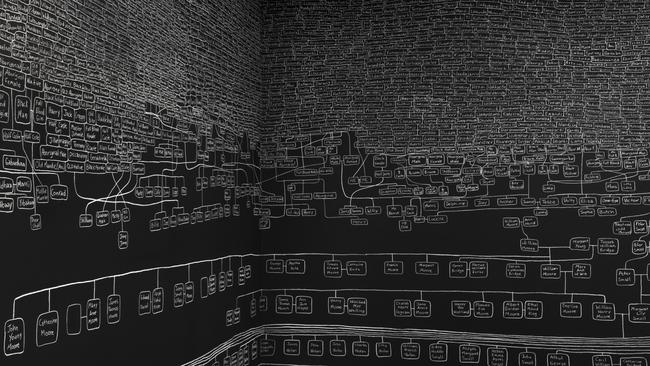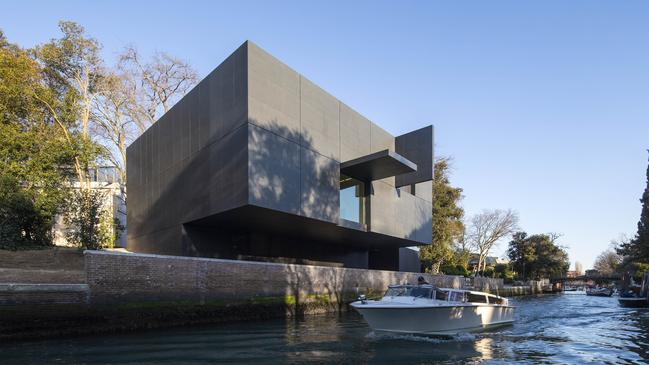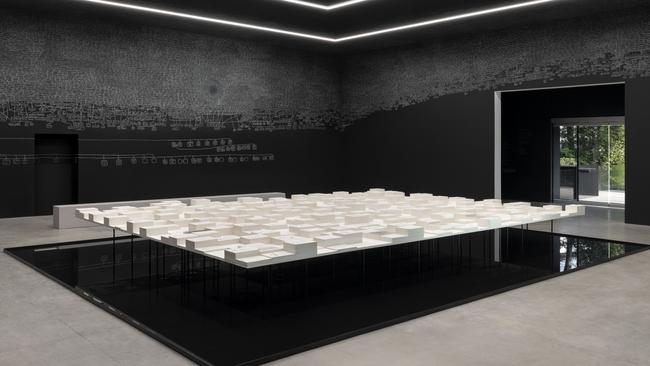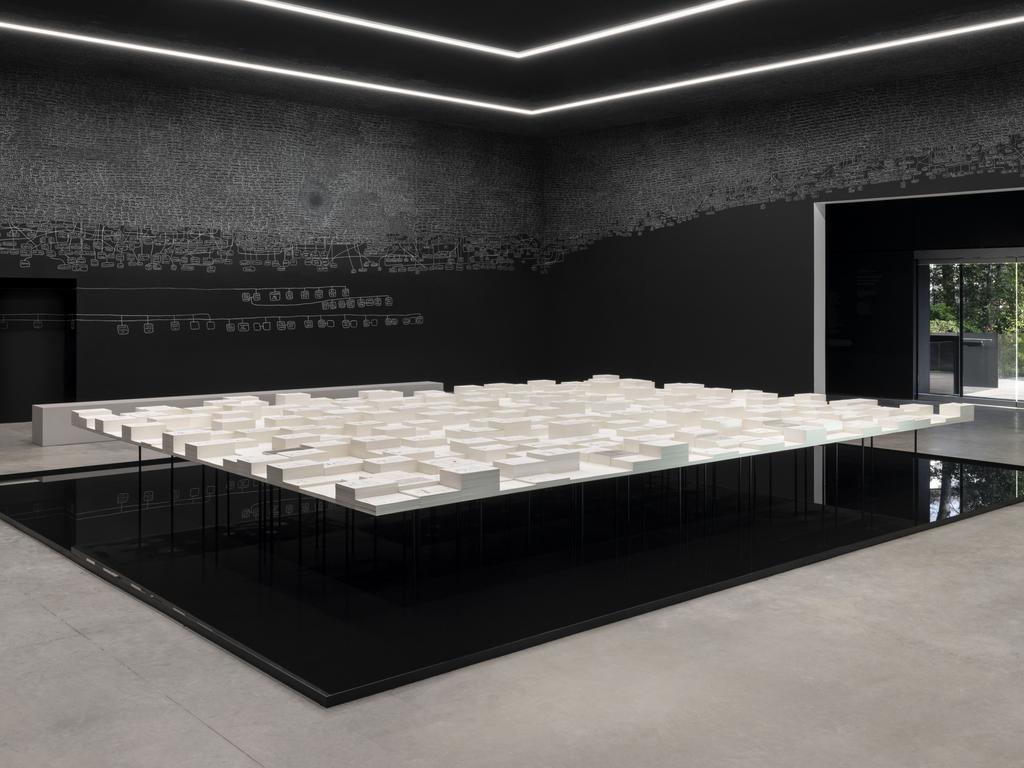Archie’s Moore’s Venice Biennale message: we are all kith and kin
This mural surrounds a memorial to Indigenous deaths in custody – a solemn reminder that First Nations Australians are among the most incarcerated people globally.

In kith and kin, his Golden Lion winning entry at the Venice Biennale, artist Archie Moore fills the Australia Pavilion with an extensive version of his Kamilaroi, Bigambul, British/Scottish family tree. This mural surrounds a memorial to Indigenous deaths in custody – a solemn reminder that First Nations Australians are among the most incarcerated people globally.
The names are handwritten in white chalk across the gallery’s 5m-high and 15m-long walls and ceiling, which are coated in blackboard paint. This seemingly limitless mural is evidence of the artist’s connection to one of the world’s oldest continuous living cultures: his First Nations Australian lineage stretches back more than 2400 generations across 65,000 years.
Through this artwork, Moore declares his sovereignty and that of his people. Only a few lines of this expansive genealogy are expressed in European languages; the great volume consists of Aboriginal names along with Gamilaraay and Bigambul kinship terms. The names of thousands of Moore’s forebears look down from overhead as viewers become engulfed in the artist’s world. The mural reaches so far back that it includes the common ancestors of all humans, reminding the audience that we are all kin.
Moore’s research shows how his family history is also the history of the continent and more recently the nation of Australia.
On his father’s British/Scottish side, there are records of a penal transport passenger list marking his great-great-grandfather William Moore’s arrival. Although landing in Australia as convicted criminals, the Moores’ luck changed. They went on to win land in a ballot devised by the states to encourage agricultural production. The acreage they won was Kamilaroi country, the land of Archie Moore’s mother’s ancestors, stolen by the colonisers.
In the research for kith and kin Moore travelled with his cousin to visit the property. Making art about kin reaffirms these family ties. The artist chose to use chalk and blackboard as markers for education. Moore (born in 1970) graduated from university in 1998, yet his mother, Jennifer Cleven (1948-2023), received only four years of schooling and had difficulty reading and writing, while her parents Joe (/John/Joseph) Clevin (/Clevens) and Vera Rose Fitz had no formal education. Theirs is not an unusual story.
Moore was not taught First Nations histories at school and his artwork goes some way to redressing this gap. Hinting in kith and kin at the breadth of Indigenous knowledge that he was deprived of, the artist unravels one thread of history so vast that it exceeds the frame of a standard classroom blackboard.

Art by First Nations people has been and continues to be a vital space for scholarship in the face of historical amnesia.
By conveying to audiences that First Nations’ history dates back millennia and includes invasions, massacres, dispossession and disproportionate incarceration, kith and kin contributes to the truth telling that is necessary to build a shared future.
Among the traces of chalk in the sprawling network are moments of erasure. These speak to incidents of physical destruction such as massacres, the introduction of diseases, the removal of children; and to incidents of spiritual and psychic destruction including historical amnesia and efforts to erase people from the public record.
The centre of the ceiling is also void of names; in the Kamilaroi astronomy the ancestors reside in the dark patches of sky between the stars, a cue that darkness, voids and abstraction do not necessarily signal the absence of life. As a white drawing on a black background, kith and kin is also a celestial map. The viewer is invited into the deep time of space, and simultaneously into the future, through the suggestion of endlessly reproduced kinship connections. By placing living and ancient kin on a single continuum, Moore evokes a Kamilaroi understanding of time in which past, present and future coexist. He posits an experience of the co-presence of ancestors and coexistence of time, enfolding us into the everywhen.

The artwork doubles as a shrine. And so, another black void occupies the centre of the gallery. It is a reflective memorial pool dedicated to First Nations people who have died or been killed in state custody since 1991.
The architectural gesture of the reflective pool originates from Persia and is found at many memorials around the world, providing a place for quiet contemplation. The reflection of the sky in the water symbolises the uniting of the heavens and earth. In kith and kin, the ancestors on the walls and ceiling are mirrored in the water.
Suspended just above the memorial pool are stacks of documents, predominantly state coronial inquests into Indigenous deaths in police custody. Like the gaps in the family tree, the water is also an abyss, one that signals the “incarceration epidemic”.

There are reports by the then Queensland Department of Aboriginals denying Moore’s grandparents exception from the Aboriginals Protection and Restriction of the Sale of Opium Act 1897, and subsequent amendments that would have enabled them access rights that non-Indigenous citizens enjoyed, such as freedom of movement, ability to control their money and to marry without approval. A prison register details Moore’s great-uncle’s removal to the infamous Boggo Road Gaol following the death of Moore’s great-grandfather because of a fight over paltry wages.
Kith and kin is a vast statement of history, yet it is an account told from a single point of view. This is revealed in the idiosyncrasy of Moore’s handwriting that spreads out from the word “me” across the pavilion. The fragility of a single point of perspective is reflected through the impermanence of chalk, which seemingly could be wiped away without a trace.
By including the shared antecedents of all humanity within the family tree, Moore pronounces that every audience member has kinship responsibilities to the artist, and to everyone else in the world. This duty is reinforced through our shared planet: Moore signals this by leaving the window of the pavilion open to reveal the Venetian canal below, a body of water that connects to the sea and in turn to all the world’s oceans.
And kinship is not limited to humans; it binds people to plants, animals, landforms and waterways throughout the ages.
Ellie Buttrose is the curator of the Australia Pavilion at the Venice Biennale, which runs until November.




To join the conversation, please log in. Don't have an account? Register
Join the conversation, you are commenting as Logout